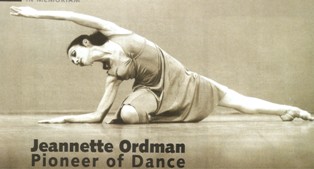
When ballet teachers here who had arrived much earlier from Russia - Valentine Archipova in Haifa, Rina Nikova in Jerusalem, Mia Arbatova in Tel Aviv, Gertrude Kraus from Germany, in Tel Aviv - each one doing her own separate "thing" in her own private studio. Classes were given, but apart from Rina Nikova's Yemenite Group which had completed a two-year tour of Europe, ending with the outbreak of WW II, there were no public performances of classical ballet by "locals" in Israel.
Jeannette Ordman was the spearhead of the Anglo influx into the Israeli dance world.
The Baroness Batsheva de Rothschild's sponsorship of Martha Graham, who had arrived earlier to establish the Batsheva Modern Dance Company, was a stepping stone in the progress of classical ballet in this country - all modern dancers are brought up on the classical medium. But how was the next step to be achieved? Jeannette and I discussed ways of setting a standard of dance throughout the country. We chose the famous and internationally accepted curriculum of the Royal Academy of Dancing (London).
R.A.D. was a method which was used extensively throughout South Africa and the Commonwealth and we decided to give a course in it for local teachers. With her usual conscientious determination Jeannette took it upon herself to make all the necessary contacts with London and the local teachers. During that time she devoted herself entirely to this project. She flew to London, presented herself for an examination on the syllabus at the Royal Academy and received the go-ahead to prepare children for examinations.
With the cooperation of Achipova in Haifa, we gathered together 20 teachers and during the Succot holidays of 1966 we taught them the children's syllabus of the R.A.D. By May 1967 we had 220 children prepared and ready. On May 25 Miss Elizabeth Glass arrived from London to conduct the first-ever examinations in Israel. She started in Tel Aviv and when she was told that the Hadera children were unable to come due to the requisitioning of private cars by the Army, she asked me to drive her to Hadera where she examined the candidates. As the British Embassy had been hounding me for days to see that Miss Glass would be on the last flight out of here, we pushed all the Haifa candidates into one day, the last day - a Saturday. All the children walked, some of them for miles, accompanied by their mothers, in order to do the examination. Miss Glass left that night and three days later the Six Day War broke out.
Since then thousands of children and teenagers in Israel have presented themselves for the annual examinations of the R.A.D. for which they receive an internationally recognized certificate. Within a few years the Israel branch of the R.A.D. comprised 70 teachers from Nahariya to Eilat and a standard of ballet was established in the country.
In 1967 Jeannette Ordman opened up the Bat Dor School and Dance company under the sponsorship of Baroness Batsheva de Rothschild. The Bat Dor School generously opened its doors to the R.A.D. Its children's syllabus was taught as well as the major syllabus to teenagers aspiring to be dancers. All examinations and teacher's courses in Tel Aviv were held in the Bat Dor School where the studios were made available free of charge in an effort to promote this foundation work.
As director of the Bat Dor School, Ordman saw to it that the students had some of the best teachers in the world, in both the classical and modern mediums, to give the classes.
Later, a branch of the school was opened up in Beersheva and scouts were sent out to the surrounding moshavim and kibbutzim to look for boys who wished to dance. Classes for all the male students in both centers were free of charge, covered by scholarships. Some of the best Israeli male dancers came from Beersheva. Years later many Israeli male dancers populated the best European dance companies. They were not only dancers but choreographers as well. Many of those who chose not to go abroad but to remain in Israel, like the exceptionally talented Ohad Naharin, director of the Batsheva Modern Dance Company, had their beginnings in the Bat Dor School.
Ordman helped solve one of the biggest problems in producing a dancer - the clash of high school demands and the demands of the dance world. At the Bat Dor School a large room was made available for the high school students where they were able to do their homework and have a rest. A refrigerator was put at their disposal for any food they had brought to eat. It is a crucial period in the life of a dancer which demands a class - and sometimes two - every day in order to maintain a high standard and to make progress. The extra costs of daily lessons at the Bat Dor were covered by scholarships.
Ordman was instrumental in instituting an exam similar to that which already existed for talented musicians going into the army - outstanding dancer (rakdan mitstayen and rakdanit mitstayenet) so that someone doing their military service would be posted close to home in order to be able to continue their dance studies.
With the wave of Russian immigrants in the 1990s, the Bat Dor Dance Company gave employment to as many dancers as possible. The Russian dancers were different in that amongst them there were family units where both husband and wife were dancers, and there were also couples with children. They arrived superbly trained in the classical technique and at the Bat Dor School they were able to adapt to the modern technique. Everything possible was done by Ordman and Batsheva de Rothschild to accommodate them.
Ordman enjoyed an international reputation as a company director and was frequently invited to sit on panels of judges at prestigious dance competitions abroad.
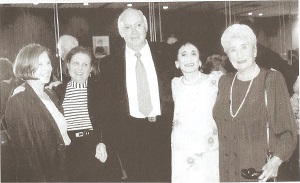
At Telfed's salute to Jeanette Ordman, Artistic Director of Bat Dor and recipient of Royal Academy of Dance (RAD) President's Award, "In recognition of her Great Contribution to Dance in Israel" under the patronage of the S.A. Ambassador, June 23, 1998 at the Bat Dor Theater in Tel Aviv: Lt to rt: Merle Guttmann, Sandra Bransky, Hertzel Katz who organized the event, Jeanette Ordman and her mother Ethel Ordman.
It is a great loss for young aspiring Israeli dancers that the Bat Dor School an Company closed down - it is truly the end of an era. It is a well known fact that dance companies only lose money and have to be state subsidized, like the Royal Ballet, the Bolshoi and Kirov. To be subsidized by the Ministry of Education and the Tel Aviv Municipality was not sufficient to keep the Bat Dor afloat. With the death of Batsheva de Rothschild the company lost its biggest sponsor.
No one should forget the monumental contribution made by Jeannette Ordman to dance in Israel over a period of 42 years. Her forcefulness and determination, together with Batsheva de Rothschild's generosity and sponsorship, gave Israel a period in which she was able to present to the world one of the best modern dance companies. Best of all, it was fed by a school of Israeli youngsters.
Ordman bequeathed her body to science and as a result there was no funeral.
Her legacy was: the establishment of the Israel Branch of the Royal Academy of Dancing; revolutionizing the situation for aspiring teenage dancers by creating the right conditions for them to continue daily lessons throughout their high school years; giving those doing military service the opportunity to continue their studies; creating the Bat Dor Company to be remembered for its brilliant level of technical prowess and beautifully staged works.
Jeannette Ordman was one of the outstanding immigrants from South Africa who devoted her life to the progress and development of the Art of the Dance in Israel.
Yonne Narunsky was the first Organizing Secretary of the Israel Branch of the Royal Academy of Dancing and a well known teacher of ballet. She passed away in 2015.
 A new website in English - on Volunteering - Launched in Israel
A new website in English - on Volunteering - Launched in Israel Honoring our distributors
Honoring our distributors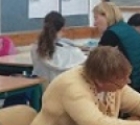 A Funny Thing happened
A Funny Thing happened  Bridesmaid recalls a very special day 59 years ago
Bridesmaid recalls a very special day 59 years ago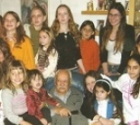 Harry Berman
Harry Berman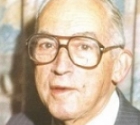 Sam Levin
Sam Levin